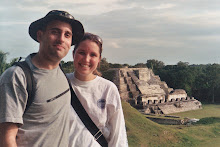 We boarded the bus for our trip to the Tamaki Maori Village. While enroute we were instructed by our guide the rules and protocol of entering a "Marae". It is customary for the welcoming tribe to send out a challenge of peace. The warrior goes through movements and recites chants until the peace offering is placed in front of the visiting tribe. If the visiting tribe did not accepted the peace offering, the welcoming tribe would kill the visiting tribe. M was chosen to represent our bus as its chief.
We boarded the bus for our trip to the Tamaki Maori Village. While enroute we were instructed by our guide the rules and protocol of entering a "Marae". It is customary for the welcoming tribe to send out a challenge of peace. The warrior goes through movements and recites chants until the peace offering is placed in front of the visiting tribe. If the visiting tribe did not accepted the peace offering, the welcoming tribe would kill the visiting tribe. M was chosen to represent our bus as its chief.When we got to the village no one was allowed entrance until the Powhiri (formal welcome) was performed. The warrior went through intimidatory gestures and displays certain movements with his Taiaha (spear-like weapon), until the Teka (peace offering) was placed and received by one of the visiting chiefs. Once the Karanga (welcoming call) was echoed throughout the courtyard, we were allowed to enter the grounds where the Tangata Whenua (people of the land) demonstrated different activities such as hand games, poi twirling, and weaponry displays.
We entered the Wharenui (big house), which is used as the meeting house. The building represents an ancestor of the Tamaki past. It is customary for women not to be seated in the front row of the meeting house because if fighting were to occur between the home people and the visitors, the men would be able to protect the women. The men also make all the welcome speeches. Here we were treated to traditional song and dance along with the Haka.
After we left the meeting house we were treated to the hangi (earth oven) a traditional dinner. The food is prepared and placed in baskets made of flax. Volcanic rock (scoria, basalt or any other type of rock that doesn't shatter when heated) line the bottom of the hole and have been heated to white hot by the native timber Manuka. The meat baskets are placed directly on the superheated stones while the vegetable baskets are then placed in the hole topped with the pudding baskets. A wet cloth is placed over the food followed by a wet hessian. Earth is piled quickly over everything to keep the heat inside the earth oven. Once this is done, the food cooks for 3 to 4 hours. We ate kumara (type of sweet potato), carrots, potatoes, coleslaw, chicken, lamb and fish for dinner and had fruit and pavalino for dessert. Everything was amazing.
 After a lovely evening at Tamaki we visited the Polynesian Spa for an hour. We soaked in heated spa water that is feed by the geyser. Since it is feed by the geyser, there is a strong sulfur smell, which can be smelled from a mile away, and any silver jewelry exposed to the water will tarnish. It sure felt heavenly to sit in water that was around 95 degrees after spending several hours on a plane, in a car, and walking around all day. It sure took out the knots and any other soreness before we called it a night at the Kiwipacka Youth Hostel.
After a lovely evening at Tamaki we visited the Polynesian Spa for an hour. We soaked in heated spa water that is feed by the geyser. Since it is feed by the geyser, there is a strong sulfur smell, which can be smelled from a mile away, and any silver jewelry exposed to the water will tarnish. It sure felt heavenly to sit in water that was around 95 degrees after spending several hours on a plane, in a car, and walking around all day. It sure took out the knots and any other soreness before we called it a night at the Kiwipacka Youth Hostel.































